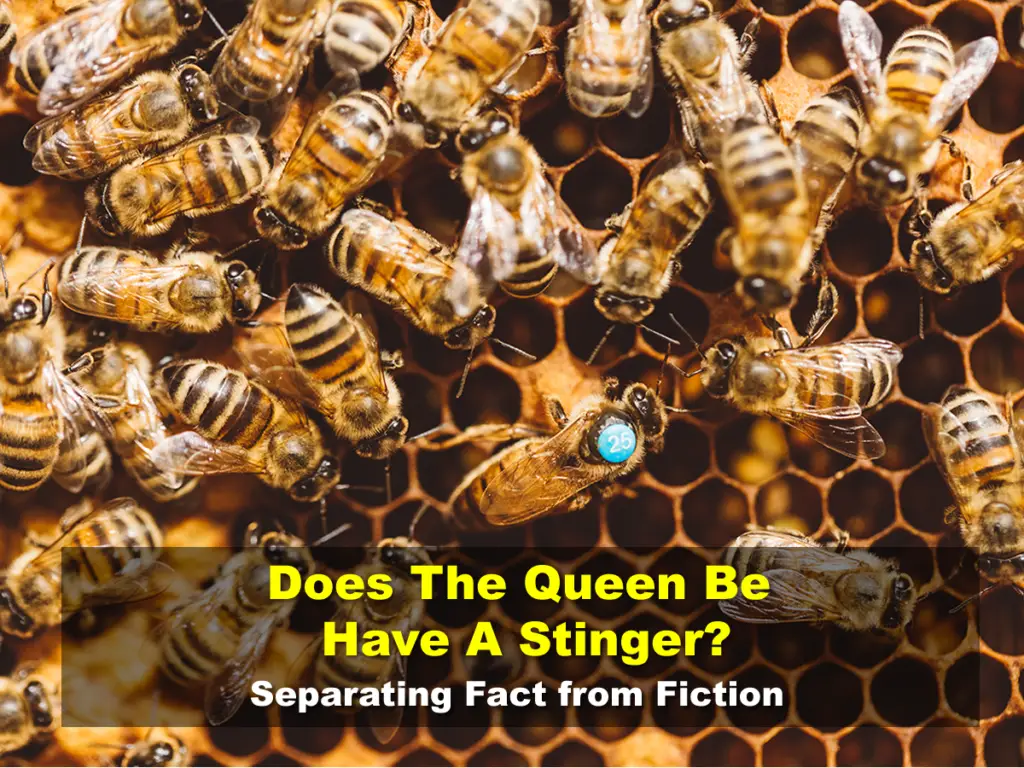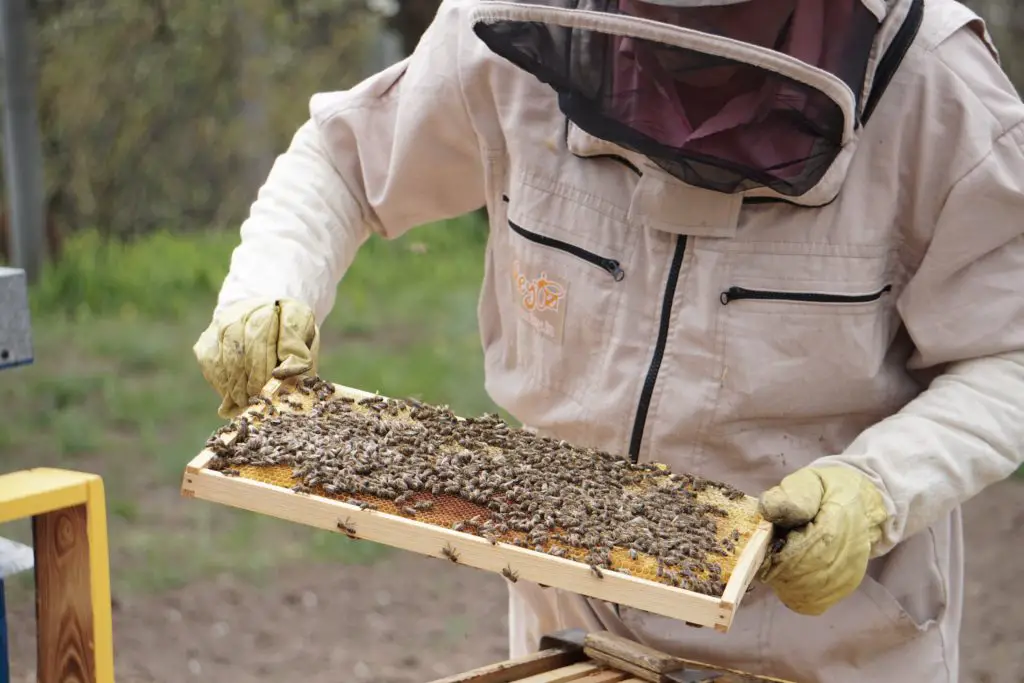Affiliate Disclaimer - As an Amazon Associate I earn from qualifying purchases.
It supports the website. So, Thank you
The social structure of the honey bee hive is incredibly complex. With tens of thousands of bees in a colony, you might think that things get pretty confusing but each bee knows its own job and the hive works like a well-oiled machine.
There is only one queen at a time in a colony and she spends most of her life inside the hive. Since bees usually use their stingers as a form of self-defense, you’d imagine that the queen had no need for one. So, does the queen bee have a stinger?
Yes. Queen bees, like all other females, have a stinger but it’s very different to that of the worker bees. Instead of being barbed, the queen’s stinger is smooth and can be used several times.
The chances of you ever running into a queen honey bee, unless you’re a beekeeper, are slim. These individuals only emerge from the hive once in their lives so they’re not often encountered by humans.
Table of Contents
What Is A Queen Bee?
Honey bee colonies usually contain at least 10,000 individuals but numbers can go into the triple figures in some cases. Every single bee within the colony has his or her own job. Some females are workers, heading out to collect nectar, pollen, and water, while some are responsible for taking care of the eggs and raising the young.
Male bees, called drones, have one simple task in life; to mate with the queen so they don’t leave the hive very often. When they do, they don’t go far compared to the female workers who can travel up to five miles in a foraging flight. Although usually, they stay within a mile of the nest, unless food sources are scarce.
Now onto the queen. There is only one queen within a honey bee colony and she’s usually much larger and more rounded than the others. It is her sole responsibility to lay eggs and ensure that colony numbers remain healthy.
Queen bees only leave the hive once and this is for a mating flight which she takes as soon as she becomes queen. During this flight, the queen will mate with as many drones as possible, storing sperm in her body which allows her to continue producing fertilized eggs for as long as she lives.
Amazingly, the queen bee can lay up to one million eggs during her life and this equates to around 2000 eggs every day.
Do Queen Bees Sting?
The big question is whether queen honey bees have a stinger. While their bodies are slightly different from workers with shorter wings and a more rounded abdomen, one part of their anatomy is very similar; their stinger.
Queen bees are, like all other females within the colony, equipped with a stinger. But what’s interesting is that queen bees have a different style of stinger to the rest of the colony.
If you look at the stinger of a worker bee closely, you’ll notice that it is barbed which allows it to stick into the victim and continue delivering venom until it is removed.
On the other hand, queen bees have a smooth, straight stinger that more closely resembles the stinger of a wasp.
Protecting Herself
Honey bees have a stinger to defend themselves. While they are generally placid creatures, they are known to sting when they feel threatened and this may happen often when they’re out of the hive foraging for food.
However, the queen doesn’t need to leave the hive apart from during her mating flight so having a stinger for self-defense seems a little pointless, right?
In some ways, yes but then you have to think about how the queen needs to protect herself against potential new queens. When a new queen is raised or introduced to the colony, she will fight the existing queen to the death for the right to be the only fertile female in the group.
The special design of the stinger means that it can be reused over and over, allowing queens to effectively fight one another.
What’s more, the queen uses her stinger to introduce eggs into the comb cells throughout the hive so it’s a very important part of her anatomy.
Do Queen Bees Die When They Sting?
The reason that honey bees die when they sting is because they have a barbed stinger. When this is inserted into the recipient, it becomes lodged and the only way for the bee to get away is by pulling itself free. But this means ripping the stinger from its body.
It doesn’t take me to tell you that ripping away a body part results in a pretty serious injury so the bee will almost certainly die thanks to this fatal wound.
However, since the queen bee’s stinger is smooth, she can simply pull it out and fly away. This allows her to use her stinger as many times as she needs. As I mentioned earlier, this is important when fighting new potential queens.
What Are The Chances Of Being Stung By A Queen Bee?
Honeybees are among some of the most docile insects on the planet. They rarely sting humans unless they feel truly threatened so the chances of getting stung overall are pretty low as long as you leave the bees alone.
When it comes to the queen, the chances are even lower because she only leaves the nest one time during her life. Studies have shown that the average mating flight lasts for around 18 minutes. When you consider that a queen bee can live for a couple of years, it just shows how little time she spends outside of the hive.
Therefore, the chance of you encountering her is incredibly low and, even if you did, she’d be more interested in getting on with the job at hand; breeding.
What Should I Do If I Get Stung?
Whether it’s a queen bee or a worker bee that stings you, the chances are that you’re going to have a sore spot for a little while. Bee stings can cause pain, inflammation, redness, and a good deal of itching so they’re never pleasant.
What’s interesting is that research shows that the venom of the queen bee is significantly less potent than that of the workers. In fact, it was discovered that queen bee venom contains 6 fewer venom ingredients compared to worker bees but there are two that are unique to the queen.
In any case, there are some people that have an allergy to bee venom and this can cause a serious, if not potentially life-threatening condition. If you are stung by a bee and have an allergy then it is imperative that you seek treatment as soon as possible.
However, for most people, a bee sting causes nothing more than superficial symptoms that can be managed at home. The most important thing, if you’re stung by a worker, is to remove the stinger as this will continue to release venom which could increase irritation.
You’ll then need to wash the area and keep it clean, allowing between seven and ten days for the wound to heal.
Final Thoughts
A lot of people are fearful of bees because of their potential to sting. However, honey bees are very docile and will only sting if they feel threatened. It’s usually the worker bees that you’ll see buzzing among the flowers and the queen only ever leaves the hive once. But does the queen have a stinger?
While the queen has a stinger, contact with humans is incredibly limited so the chance of getting stung is very low.




